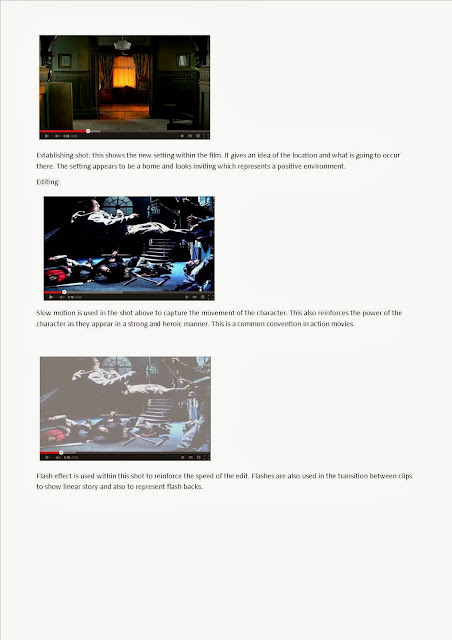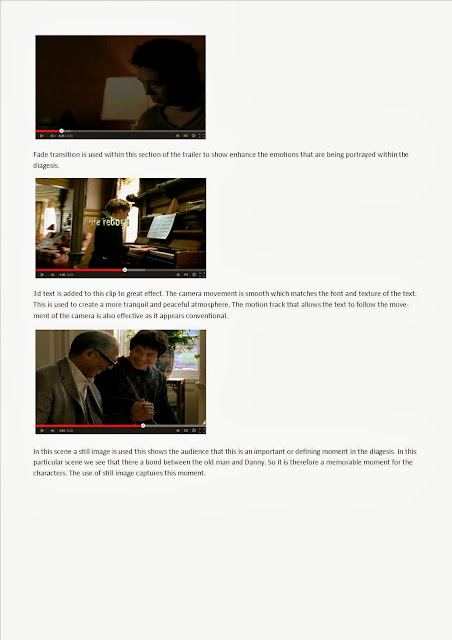What is a movie trailer?
A trailer or a preview is an advertisement for a feature
film that will be screened in the future in cinemas. Film trailers were
originally screened at the end of a feature film screening. This did not last
long as the audience generally left the theatre one the film had ended. To
solve this problem they began to show trailers before the start of the film and
this method of advertising has stuck. The term “trailer” is still used today for
trailers within the cinema and through other mediums such as: internet, TV and
DVDs. Movie trailers have become increasingly popular within the internet
specifically through YouTube. Around ten billion videos are watched online
annually with film trailers being ranked third, after news and user-created
content.
In earlier decades of cinema, trailers were only one part of
the entertainment. In addition to the trailer short cartoons and serial
adventure episodes were included. The early trailers were simple and only
consisted of little more than title cards and stock footage. Today movie
trailers are longer and more elaborate and commercial advertisements have
replaced other pre-feature entertainment in major multiplex chains. Around the
first the first twenty minutes after the posted show time is devoted to
trailers.
The first film trailer show in the US was in November 1913,
when Nilis Granlund, the advertising manager for the Marcus Loew theatre chain,
produced a short promotional film for the musical The Pleasure Seekers, opening
at the Winter Garden Theatre on Broadway. The Nebraska daily star described it
as” an entirely new and unique stunt”.
Up until the late 1950’s, trailers were most commonly
created by the national screen service. They consisted of various key scenes
from the film being advertised. They also had large, descriptive text
describing the story. The background music was usually taken from studio music
libraries and then. Most trailers during that time had some form of narration
which would have been featured stentorian voices.
Im the early 1960’s the face of movie trailer pictures
changed, the trailers became text less, montage edits and fast paced edits lead
a completely new type of trailer. This change was largely due to the arrival of
“new Hollywood” and techniques that were used within television at that time.
Among the trend was Stanley Kubrick montage trailer Lolita, Dr. Strangelove.
Kubrick gained inspiration from a Canadian film visionary Arthur Lipsett.
Where they are produced
Film trailers for Hollywood movies are usually created by
studios in Los Angles and New York. There are many renowned agencies that
create movie trailers such as The Cimarron Group, MOJO, The Ant Farm and
Trailer park. The trailers are often
created before or during the production of full length film. This means that
trailers often consist of songs and scenes which are not within the full film.
Some trailers incorporate material that is not within the
finished film. These trailers are particularly desired by collectors, in particular
trailers for classic films. In the movie Casablanca the character Rick Blaine
says, “Okay you asked for it!” Before shooting Major Strasser this is an event
that does not occur within the full feature-length film.
Casablanca trailer: http://www.youtube.com/watch?v=4rguz_XRi8E
Truth Vs misleading
There are many examples in which trailers give misleading
representations of their films. Some trailers give the impression that a
particularly famous celebrity will be extensively featured within the film
however, they actually only play a minor part within the film. Furthermore,
some trailers advertising a musical for example that is directed at the female
demographic due to stereotypes surrounding the film studio making it. May
portray the film as being action packed which may not be the case. The use of
theses tricks allow the film to draw in a larger audience.
The trailers could be misleading for the audiences “own
good”. The audience may not watch such a film due to their initial
preconceptions, the use of the bait and switching allows the audience to have a
greater viewing experience that they wouldn’t normally have. However, it could
create negatives such as having amazing trailers that promise a lot but average
films that don’t live up to the expectations. An American woman sued the makers
of'Drive' because their film failed to meet the promos promises.
Three-act structure
Most trailers have a three-act structure relating to the full
length-feature film. They start with the beginning (act 1) that lays out the
premises of the story. The middle (act 2) drives the story further and usually
ends with a dramatic climax. Act 3 usually features a strong piece of
"signature music" (either a recognizable song or a powerful, sweeping
orchestral piece). This last act often consists of a visual montage of powerful
and emotional moments of the film and may also contain a cast run if there are
noteworthy stars that could help sell the movie.
Voice-over
Voice-over narration is used to briefly set up the premise
of the film and provide explanation when necessary. Since the trailer is a
highly condensed format, voice-over is a useful tool to enhance the audience's
understanding of the plot. Some of the best-known, modern-day trailer
voice-over artists are Don LaFontaine, Hal Douglas, Mark Elliot, John Leader,
Corey Burton, George DelHoyo, Peter Cullen and Morgan Freeman.
Classic voice-over artists in film trailers of the 1950s and
1960s included Art Gilmore and Knox Manning. Hollywood trailers of the classic
film era were renowned for clichés such as "Colossal!",
"Stupendous!” etc. Some trailers have used voice over clichés for
satirical effect. This can be seen in trailers for films such as Jerry
Seinfeld's Comedian and Tenacious D in The Pick of Destiny.
Tenacious D in The Pick of Destiny trailer: http://www.youtube.com/watch?v=wZ-i5gwZNjU
Information gathered from
http://en.wikipedia.org/wiki/Trailer (promotion)
The format of movie trailers
Trailers tend to follow the same structure as the films they
are based on. They have an introductory sequence, followed by a problem, and
then a solution. This shows the audience where the film is based, the
characters and actors who play them, and what the film is based on. This format
has been argued to reveal the story in the trailer. Some people suggest that
all the best bits of the film are put into the trailer to make the film more
appealing, but the rest of the features leave a lot to be desired.
Trailers have three acts’, and it is common to have three
different songs. The songs used within the trailer are often not within the
film. This is because the film trailer is created before post production and
the sound track is usually added at the end of the films production. Composers
are usually the last creative people to work on the film.
Some trailers contain scenes that are not actually within
the finished film. This is most evident in the 6 minute trailer for the
Hitchcock film ‘Psycho’ in which the whole trailer shot post production. This
trailer actually included a different actress for the main role. However in
some trailers scenes are cut out. In the ‘Spiderman’ trailer there was a scene
in which there where criminals near the World Trade Centre. The film was
released soon after the terrorist attack at the World Trade Centre. Therefore
it would have been controversial to show this scene when the area was still
sensitive.
Conclusion
Researching the history of movie trailers has been
beneficial as it has allowed me to gain background information on my chosen
form. Movie trailers have a short history of under a hundred years. However,
there have been great changes during this length of time. The conventions and
structure has changed greatly and now trailers are arguably one of the most important
parts of a film. The trailer allows the
audience to gain the initial idea of whether or not they will find the film
interesting or not. The trailer attracts a large audience and therefore is
crucial in making profit. The editing within the trailer needs to be seamless to
create an effective image.


























